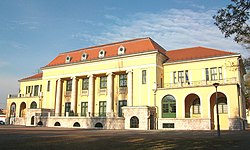Dorog
| Dorog | ||
|---|---|---|
| Town | ||
 |
||
|
||
| Location of Dorog in Hungary | ||
| Coordinates: 47°43′10″N 18°43′45″E / 47.71944°N 18.72917°ECoordinates: 47°43′10″N 18°43′45″E / 47.71944°N 18.72917°E | ||
| Country |
|
|
| County | Komárom-Esztergom | |
| Government | ||
| • Mayor | János Tittmann Independent | |
| Area | ||
| • Total | 11.55 km2 (4.46 sq mi) | |
| Population (2011) | ||
| • Total | 12,199 | |
| • Density | 1,100/km2 (2,700/sq mi) | |
| Time zone | CET (UTC+1) | |
| • Summer (DST) | CEST (UTC+2) | |
| Postal code | 2510 | |
| Area code(s) | 33 | |
Dorog (German: Drostdorf) is a small town in Komárom-Esztergom, Hungary. It lies 38 km (24 mi) north-west from the center of Budapest.
The valley between the Pilis and Gerecse mountains has been inhabited since the Neolithic. A Roman military road westwards from Aquincum passed by the present-day town of Dorog, where Roman dwellings with floor heating have been found, along with conduits, graves and milestones. When Hungary's kings resided at Esztergom in the 11th and 12th centuries, Dorog was where the cooks of the castle lodged. Roads from all directions met here in the Middle Ages, and the Chapter of Esztergom had the right to levy custom duties. The name, which appears in from Durug, Drug and Durugd, is first mentioned in an extant document in 1181.
The medieval settlement, destroyed in the Ottoman invasion, remained uninhabited from 1542 until 1649. German settlers then arrived in three waves, followed by Hungarians again. Dorog in the 18th century became a centre of communications again. Regular 19th-century visitors to the posting inn on the Buda–Vienna road included philologist Ferenc Kazinczy, statesman István Széchenyi and magnate Ferenc Wesselényi. New houses and streets sprang up round the baroque Roman Catholic church built in 1767–1775.
The first written contact on mining coal at Dorog, dating from 1845, was drawn up between the Capter of Esztergom and the colliery managers Ferenc Wasshuber and József János Jülke. Thereafter, many great engineers became involved in developing the Dorog mines, including Vilmos Zsigmondy, the geologist Miksa Hantken, and the mining engineers Henrik Drasche and Sándor Schmidt, who opened up and directed exploitation of richer and richer seams. Dorog, around the start of the 20th century, was a major mining centre, connected by rail (originally HÉV) with Budapest and by canal with the Danube. In 1906, Dorog's power plant was constructed (which was rebuilt in the 1980s with a 120-metre (390 ft) high chimney). In 1900 Dorog had 1966 inhabitants (1369 Germans, 477 Hungarians, 55 Slovaks).
...
Wikipedia


